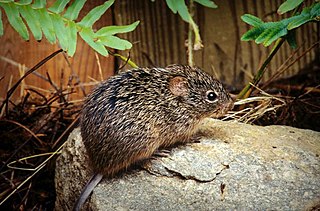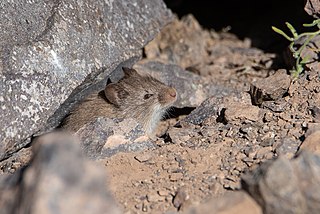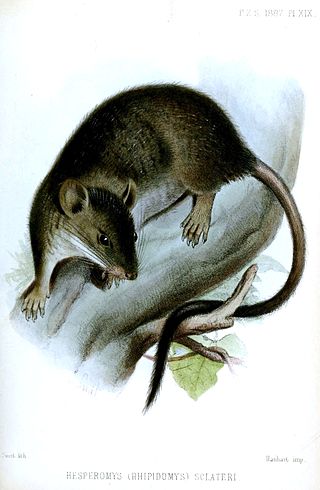
The rodent subfamily Sigmodontinae includes New World rats and mice, with at least 376 species. Many authorities include the Neotominae and Tylomyinae as part of a larger definition of Sigmodontinae. When those genera are included, the species count numbers at least 508. Their distribution includes much of the New World, but the genera are predominantly South American, such as brucies. They invaded South America from Central America as part of the Great American Interchange near the end of the Miocene, about 5 million years ago. Sigmodontines proceeded to diversify explosively in the formerly isolated continent. They inhabit many of the same ecological niches that the Murinae occupy in the Old World.

The New World rats and mice are a group of related rodents found in North and South America. They are extremely diverse in appearance and ecology, ranging in from the tiny Baiomys to the large Kunsia. They represent one of the few examples of muroid rodents in North America, and the only example of muroid rodents to have made it into South America.

Akodon is a genus consisting of South American grass mice. They mostly occur south of the Amazon Basin and along the Andes north to Venezuela, but are absent from much of the basin itself, the far south of the continent, and the lowlands west of the Andes. Akodon is one of the most species-rich genera of Neotropical rodents. Species of Akodon are known to inhabit a variety of habitats from tropical and tropical moist forests to altiplano and desert. Fossils are known from the late Pliocene onwards.

Oligoryzomys nigripes, also known as the black-footed colilargo or the black-footed pygmy rice rat, is a rodent in the genus Oligoryzomys of family Cricetidae. Oligoryzomys nigripes is a species that has been further divided into different sister taxa throughout history. It is found in different countries in South America. It is a large species with long ears, dark yellow to dark brown upperparts, sharply delimited from the whitish underparts, and often a pink girdle on the chest. This species of rat spends much of its life among the trees. The karyotype is 2n = 62, FNa = 78–82.

Rhipidomys is a genus of rodents in the family Cricetidae, The following 25 species of climbing mouse species are currently recognised:

The plateau vole is a species of rodent in the family Cricetidae. It was originally listed as Lasiopodomys, but was moved to Neodon in 2012. It is found only in China. Its natural habitat is temperate grassland.
The southern climbing mouse is a species of rodent in the family Cricetidae. It is found in Argentina and Bolivia in forested valleys and on slopes on the eastern side of the Andes Mountains.
The Cauca climbing mouse is a species of arboreal rodent in the family Cricetidae. It is endemic to Colombia, where it is found in montane forest at elevations from 2200 to 3500 m.
Coues's climbing mouse is a species of rodent in the family Cricetidae. It is found in Colombia, Ecuador, Peru, Trinidad and Tobago, and Venezuela. It is named in honour of the American zoologist Elliott Coues who studied birds and small mammals.
The buff-bellied climbing mouse is a species of rodent in the family Cricetidae. It is found in Colombia and Venezuela.
The broad-footed climbing mouse is a species of rodent in the family Cricetidae. It is found in Colombia, Ecuador, Panama and Peru.
The yellow-bellied climbing mouse is a species of arboreal rodent in the family Cricetidae. It is known only from southeastern Peru, where it has been found in cloud forest at an elevation of 1830 m. This species was long known only by the type collection until it was rediscovered in May 2010.
The charming climbing mouse is a species of nocturnal rodent in the family Cricetidae. It endemic to Venezuela.
Wetzel's climbing mouse is a species of rodent in the family Cricetidae. It is endemic to Venezuela.

The Atlantic Forest climbing mouse is an arboreal rodent species in the family Cricetidae from South America. It is found in the Atlantic Forest of southeastern Brazil at elevations from sea level to 1500 m. It utilizes the ground more than the understory in isolated forests however this utilization changes in certain areas of the Atlantic Forest where it prefers to use the vegetation canopy. Its karyotype is 2n = 44, FN = 74–80.

The cerrado climbing mouse or long-tailed rhipidomys is an arboreal rodent species in the family Cricetidae from South America. It is found in primary or secondary forests of the cerrado and caatinga in central and eastern Brazil, and has also been seen in the Atlantic Forest. Its karyotype is 2n = 44, FN = 48-52. They are nocturnal animals and can be found in both tree canopies and on the ground.
The Peruvian climbing mouse or lesser Peruvian rhipidomys, is a South American species of rodent in the family Cricetidae. It is endemic to the eastern slopes of the Andes in central Peru, where it is found at altitudes from 700 to 1,800 metres. The species is nocturnal and arboreal, and lives in lower montane forest and cloud forest. It is threatened by forest clearance for agriculture and coca cultivation but is listed as a "least-concern species" by the International Union for Conservation of Nature.
Rhipidomys ipukensis, also known as the Ipuca climbing rat, is a species of rodent in the family Cricetidae. It is found in the state Tocantins of Brazil.
Rhipidomys itoan, also known as the sky climbing rat, is a species of rodent in the family Cricetidae.It is found in Brazil.
Rhipidomys tribei, also known as the Tribe's climbing rat, is a species of rodent in the family Cricetidae. It is found in the state Minas Gerais of Brazil.






